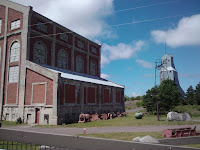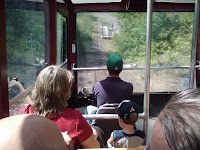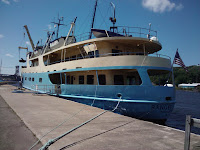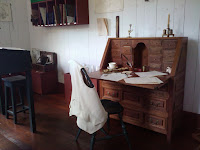 |
| View near Eagle Harbor |
The Keweenaw (pronounced key-wah-nah) Peninsula is on the western end of Michigan's Upper Peninsula. It's known for having very pure copper ore, first found and used by Native Americans and then by enterprising early industrialists. The
Keweenaw National Historic Park preserves its mining history by bringing together a variety of not-for-profit organizations with that same preservation mission. It is an unusual National Park Service entity in that it has very few land holdings of its own.
 |
Quincy #2 Mine Shaft in the distance
with its Hoist House in the fore |
For my first day, I took a gorgeous drive out to Copper Harbor via Eagle Harbor. On the way, I visited a black smith display and saw a lighthouse museum. But the real joy was the drive itself and the views along the way.
 |
| Massive Quincy Hoist |
I filled my next day with a couple of ranger-led tours at both the Quincey and Calumet Units, as well as a park-partner tour of the Quincy Copper Mine. By the way, all of the copper mines on the peninsula are no longer in operation. The cost of mining the deeper ore is no longer profitable.
 |
View of Quincy #2 Mine Shaft
from its Hoist House |
First I toured the Quincy Mining Company. When the copper mines began operation, many of the skilled miners were Finnish immigrants, recruited to work in these mines because of their experience in the mines of their homeland. Immigrants from other countries mainly performed tasks that required less or no skill. It was hard work, long hours, and they were only paid for the work they did once they reached their workplace inside of the mine itself. The trip into the mine, from home to workplace could take as long as two additional hours, one way. The work was dangerous and many lost their lives.
 |
One of the steam-powered
pistons for the hoist |
Miners and management with the most seniority lived the closest to the mine itself. Although that seemed odd to me at first, I realized that winters in this area are brutal and the miners would need to first fight through the snow and cold to walk to the mine, and the closer one is to his work site, the less hours away from home.
Skilled miners bored deep holes, first with hammer and long chisels, then with more progressively sophisticated pneumatic drills as time went on. Explosives would be placed into those holes to break up the rock so that the unskilled workers could then shovel the rock into containers for transport up through the shaft to the surface were the rock would be separated and the copper processed into ingots for transport.
 |
small scale model showing
the device that miners
road to get into and out of
the mines |
I was amazed at the ingenuity of the technology. The Quincy Mine shaft #2 was 9,260' deep. To move the men down to work, and the rock up to be processed took a lot of energy. The world's largest steam-driven hoist was installed. The efficient Nordberg steam technology was housed in a Hoist Building which became the centerpiece of the Quincy Copper Mining Company to show off its technology to investors and potential investors. Even the building itself was impressive, with brick veneer, marble tile from Italy, stained glass windows, and brass fixtures.
 |
miners sat two abreast on
this car to get into and out
of the mine |
The technologies to get the miners into and out of the mines improved over time. First just plain ladders were used, then it was a contraption that looked like a big stair case with about a 5' rise and a vertical cut straight down the middle when it wasn't moving. But, when it moved, it scissored 5' back and forth so that a miner could go up or down by moving from one side of the stair step to the other, before it scissored again. It was dangerous, especially when two miners met, one going up and the other going down, on the same stair step. The final technology to transport miners looked like a narrow set of bleachers where they sat two abreast.
 |
view from on top one of the poor
rock piles |
Several poor rock piles were scattered around, we climbed on to get a better view of the area. Poor rock is the left over rock after the copper has been picked out after mining.
 |
Taking a cog rail car to an adit
(horizontal mine entrance) |
I took a cog rail tram car down a very steep hill to a horizontal opening into the #5 shaft, and then rode a tractor-pulled trailer into the mine itself for a
guided tour. This particular entrance was used to pump water out of the shaft when it was in operation. Since all of the mines have closed and water no longer pumped out, they've natually filled up with water to the level of the local water table.
 |
Trailer pulled by a tractor took us
1/2 mile into the mine. |
Upon entering the mine, we donned hard hats and jackets for the chilly environment. We were shown examples of the drilling tools -- the progression from manual chisel and hammer to the automatic pneumatic drill.
 |
the light at the
end of the tunnel |
The guide shared the history of worker-management relations. At the beginning management was very paternal, providing homes, churches, and company stores. The miners had little if any rights. The guide further explained, that although the more modern pneumatic tools made drilling more efficient, it also allowed the management to cut the number of skilled labor needed. This caused labor anger and uprising. Progressively, the miners organized themselves into a union, demanding better working conditions and employment security. Working conditions did improve, but higher labor costs eventually help to contribute to the closing of the mines.

The mine was dark, so I didn't get any publishable pictures. Except the proverbial "light at the end of the tunnel" pic.
The Calumet Unit, about 12 miles north of Quincy, focused on the community history of Copper Country. Here I went on a guided ranger tour of the town where he pointed out many of this historic sites.
He shared that the mining companies would encourage keeping the various ethnicities of workers separate in their individual communities to discourage discussion and labor organization. In fact, important communications while in the mines were done by bells and whistles to deal with the language barriers.

So, each ethnic community had it's own church. Here are some pictures of some of them.
 |
This building was a department store, now
an art gallery |
Of note is that the main
Isle Royale National Park Visitors Center is also located on the Keneewaw Peninsula, where you can ferry to the island from either the Visitors Center in Houghton or from Copper Harbor. I choose to take a different ferry, later in my trip, from Grand Portage, Minnesota because it's a shorter, less expensive voyage ... even though Isle Royale is actually in Michigan. I'll have more on that adventure in a later blog post.
 |
Isle Royale's Ranger III off loading a passenger's boat at its Houghton dock |
originally posted 9/5/10





















































